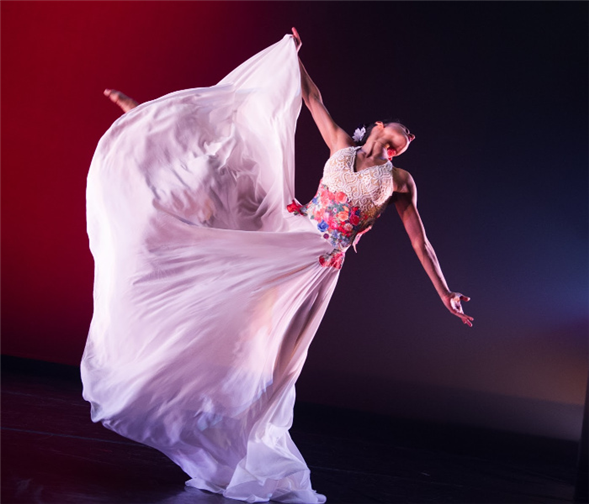Translate Page

How the dancer became the "anchor" of the company's spring run at the Joyce
---
Rehearsing for Ballet Hispánico's upcoming run at the Joyce (March 26-31), seven-year company veteran Melissa Verdecia moves without a fingertip of superfluous effort. As she runs through a section of Bennyroyce Royon's Homebound/Alaala, her lithe arms flap once, then twice before framing her head like a halo. Next, she finishes two kicks, her legs moving with piston-like precision before she lands on relevé with a lifted heel. It seems like she could stay there balanced indefinitely as she casually turns to ask another dancer a question. Even though her limbs slice powerfully through the air, she remains grounded and calm.
This signature style clearly impressed the program's trio of choreographers: Royon, Edwaard Liang and Annabelle Lopez Ochoa. Verdecia is featured in all three works: world premieres Homebound/Alaala and el Viaje, plus an all-female reworking of Sombrerísimo. In the first two, she plays a maternal figure, "the anchor," as she calls it. For her that's a huge but natural shift.
"I started in the company at 23, and I'm about to turn 30," she says. "When I entered, my friend and I were the 'babies.' Now, even though I can do the same physical things as the younger dancers, on an emotional level the work is richer. Perhaps since I'm recently married [to company member Lyvan Verdecia], too, the choreographers see me more as a grown woman. But really, I've always been maternal. I like to be a guide, a leader. Now I'm dancing that."
Royon and Liang's pieces explore the connections between the Latinx and Asian diasporas. In Liang's el Viaje, which translates as The Trip, Verdecia portrays a Chinese woman who immigrated to Cuba in the '40s. "She's trying to assimilate into this new culture, and there are moments where I'm just observing," Verdecia says. "As a dancer that's really hard, to just stand still. So I have to make something of the stillness. The character is the anchor for the piece, representing the hopes and dreams of people. I'm still working through the process and energy changes onstage. You come alive in a different way. How will I stay true and interpret this without looking like I'm not doing anything? What's the middle ground between acting and dancing? Edwaard choreographed the piece in four days. He knows what he wants, gives it to you, and then you work together to simply hone it.”
Royon's Homebound/Alaala, which centers on a big Filipino family, was a more collaborative experience. "We came up with movement and he manipulated it often," Verdecia says. "It was definitely a melting pot of ideas, and he also encouraged us to have our own stories. In one section, I open up a box and take out flip-flops, an iconic item in Benny's culture. He told me I needed to find an attachment to the box. I told him what I was thinking of, and he liked it. He doesn't want to spoon-feed it to you."
As they developed the piece, Royon brought in a friend to teach Filipino folk dance to the performers. "It was often minimal movement, like just isolating wrists or the hands," Verdecia recalls. "It was a cool challenge and informative."
While Liang choreographed el Viaje in just four days, Royon's Homebound/Alaala took four weeks. "He really wanted us to dive into an emotional space," Verdecia says. "Benny was adamant that we needed to find this internal story and connect with our peers, talk to each other and explain our thoughts to fill in all the gaps. As dancers, sometimes you just use movement to transition, but Benny wanted us to link that together mentally and emotionally."
{Image1}
Verdecia recalls seeing Lopez Ochoa's meditation on identity, Sombrerísimo, performed by its original cast of men. "I remember I was a little bit jealous," she admits. "It was such a crowd-pleaser from the instant it premiered. I wanted the women to have a fierce piece just as sexy and strong." Back then she even joked with her female colleagues that they should learn the dance and perform it for Ballet Hispánico's artistic director Eduardo Vilaro for fun. Now, dancing it with all women feels like a dream realized. "It's a virtuosic piece," she says. "While there are some adjustments in terms of lifts and tricks, if anything, we've given it even more sensual energy that perhaps the male cast couldn't tap into as much."
While Verdecia thinks the movement is largely gender neutral, now that women are dancing it, the execution feels more feminine. "There's a part where all six dancers walk in a strong and sensual way downstage, and all the audience sees are faces," she says. "When I saw it, it felt so masculine, but now with women, it speaks louder. We are accepting and embracing women's power: We birth the child, we are strong emotionally, we're the anchors."
---
TDF MEMBERS: At press time, discount tickets were available for Ballet Hispánico's Joyce Theater run. Go here to browse our current offers.
Lauren Phoenix Kay regularly contributes to TDF Stages.
Melissa Verdecia in Ballet Hispánico's Con Brazos Abiertos. Photo by Paula Lobo.